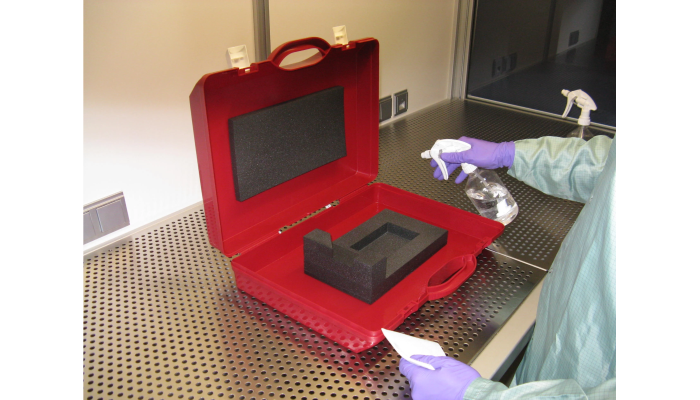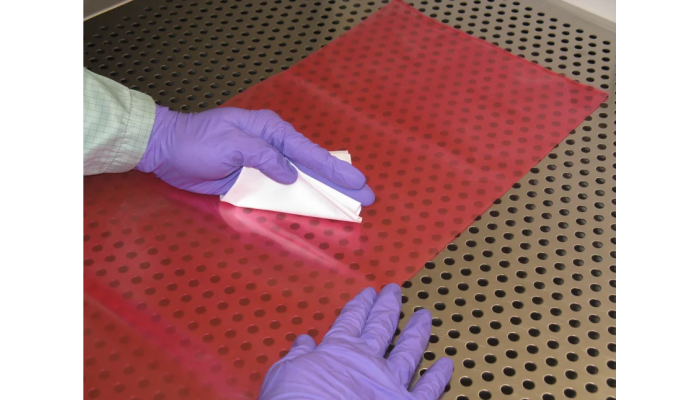Definition and Advantages of a Cleaning Laboratory
Regular cleaning of a cleanroom is widely recognised by cleanroom users as an important factor in maintaining the required air cleanliness class in...
To clean machines efficiently, wipe cleaning is used almost exclusively, as this is the most suitable method for the cleaning process. In this blog post, we will introduce you to manual wipe cleaning in detail.

It is obvious that machines should only be brought into the cleanroom when they are clean. Nevertheless, they must be cleaned at regular intervals, just like the cleanroom. Because even if the cleanroom fulfils all requirements, particles and molecular contaminants can still settle on machines and components, significantly affecting the quality of the production process and therefore the product.
Despite being positioned in a cleanroom, machines and individual assemblies can contribute to a reduction in the air cleanliness class because of their design. Due to the specific geometry, such as corners, edges or other areas on the machine surface that are difficult to reach, there are places on which additional particles can be deposited. In particular, effects of ageing, changes in the air temperature and humidity in the room itself or changes in the surface charge of the machines can have a negative impact on the attraction between particles and the surfaces of the machines, making it easier for particles to enter the clean environment. In addition, particle release and the emission of molecular contaminants by the machine itself play a significant role in machine cleanliness.
In principle, a wide variety of processes can be considered for cleaning in the cleaning laboratory. For cleaning, the machines, individual components or assemblies are transported to the cleaning laboratory, disassembled as far as possible, cleaned using the correct procedures, then properly packaged and finally returned to the customer or cleanroom.
However, there is also the option of on-site cleaning if required by customer conditions.
In addition to the wipe cleaning method discussed below, other cleaning methods can also be used to clean the machines. However, these cleaning methods are only used in certain cleaning cases, depending on the requirements of the machine.
You can find more information on the cleanroom technology overview page!Wipe cleaning by means of solvents (water is also a solvent) allows a cleaning method that also permits non-standardised or automated cleaning processes. In addition to the high flexibility of the process, wet cleaning allows not only the pure mechanical cleaning principle to be implemented, but also the dissolving power of the respective agent to contribute to the additional cleanliness of the process. In addition, the wipe cleaning method does not leave any residue on the machine or component surface, as the solvents used generally consist of isopropanol and DI water.
The mixing ratio is less important than the mixture itself. Isopropanol has dissolving properties, but is difficult for the wipe to absorb due to its low surface tension. By adding DI water, this surface tension is increased and the liquid with the dissolved impurities is literally absorbed by the wipe.
It is not only the mechanical effect and the special features of the solvent used that contribute to effective cleaning of the parts in the cleaning laboratory, the cleaning itself should also be carried out using the right cleaning cloths and thus be particularly efficient and gentle. Wipes with the right level of cleanliness have a positive effect on the cleaning result.
Due to the advantages of wipe cleaning, it is the method of choice for cleaning under cleanroom conditions. A wide range of different surfaces and materials can be cleaned gently, flexibly and cost-effectively, making them ready for using again in a clean environment.
Would you like to find out more about the special features of cleaning under cleanroom conditions? Then download our whitepaper.

Regular cleaning of a cleanroom is widely recognised by cleanroom users as an important factor in maintaining the required air cleanliness class in...

In order to properly specify the cleanliness of a machine in advance, it is necessary to analyse the entire process chain from the production of...

For some years, the term ‘grey room’ has been used in customer discussions and specialist articles. But how exactly is a ‘grey room’ defined? And how...